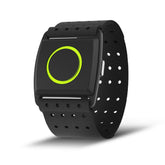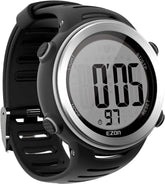Climbing Mastery: Heartbeat Monitors for Precise Exertion Management
Climbing is a battle against fatigue—where a single misstep due to wasted energy can end a climb. Mastery comes not just from strength, but from knowing when to push and when to pause. A heartbeat monitor transforms this balancing act into a science, turning your heart rate into a precise gauge of exertion. By tracking every beat, you’ll learn to manage energy like a pro, extending climbing duration, nailing tough cruxes, and turning near-misses into successful sends. EZON’s Heart Rate Series and Sports Watch Series are built for this—durability, accuracy, and real-time alerts to keep you in control, whether on indoor boulders or outdoor multi-pitch routes.
Why Exertion Management Makes or Breaks Climbs
Climbing success hinges on energy efficiency:
- Short Climbs (Bouldering): 3–5 minute efforts demand controlled intensity—spiking exertion too early drains grip strength for the final hold.
- Long Routes (5.10+): Sustained effort over 10+ minutes requires pacing—burning too much energy on easy sections leaves you gasping at the crux.
- Multi-Pitch Climbs: Hours of climbing demand stamina—cumulative exertion without rest leads to errors on later pitches.
A heartbeat monitor like the EZON C009Pro (from Heart Rate Series) quantifies this: “My heart rate is 82% MHR—I need to ease back before the overhang” replaces vague fatigue. This precision lets you climb longer, with more control, and finish stronger.
Decoding Heart Rate Zones for Climbing
Your heart rate reveals exactly how hard your body is working—use these zones to manage exertion:
-
Zone 1 (50–60% MHR): Active Recovery
Gentle movement (e.g., easy traverses) to flush lactic acid. Use this during rests between attempts or on flat sections of multi-pitch routes. -
Zone 2 (60–70% MHR): Endurance Base
Ideal for sustained, moderate climbs (5.8–5.10). Your body burns fat efficiently here, preserving glycogen for harder sections. Most of your climbing duration should stay in this zone. -
Zone 3 (70–80% MHR): Controlled Effort
For cruxes or steep sections (5.10–5.11). Short bursts here are safe, but lingering >2 minutes drains energy—use this zone strategically, not continuously. -
Zone 4 (80–90% MHR): Maximum Effort
Reserved for 1–2 minute sprints (e.g., dynos on boulders or final pushes on 5.12+ routes). Treat this as a “power reserve”—overusing it cuts climbing duration by 30%+.
Exertion Management in Action: Climb Types & Strategies
1. Indoor Bouldering (Short, Intense Efforts)
Bouldering demands explosive strength—manage spikes in exertion to avoid burning out mid-problem:
- Pre-Climb: Check resting heart rate (RHR) with EZON R7 (from Sports Watch Series). A 5+ BPM rise from baseline means scale back effort (stick to Zone 3, not 4).
- During Climb: Use C022Pro armband (Heart Rate Series) to track spikes. If heart rate hits 85% MHR before the crux, pause for 2 deep breaths—letting it drop to 80% MHR restores grip strength.
- Post-Attempt: Rest until heart rate returns to <65% MHR (3–5 minutes). Rushing back increases error rate by 2x.
2. Single-Pitch Outdoor Climbs (Moderate Duration)
Longer routes require pacing—balance effort to reach the top with energy to spare:
- Lower Section (0–30%): Stay in Zone 2 (60–70% MHR). Even easy holds deserve steady effort—avoid surging (spiking to 75% MHR) to conserve energy.
- Mid-Route (30–70%): Allow brief dips into Zone 3 for tricky moves, but recover immediately (drop to 65% MHR) on rests. R7’s GPS marks route segments, so you compare effort across climbs: “This 5.10’s mid-section keeps my heart rate 5 BPM higher than last week’s—grips are smaller, so I need to rest more.”
- Final Push (70–100%): Use Zone 3–4 sparingly. If heart rate hits 85% MHR with 10 feet to go, lean into it—you’re close enough to finish before fatigue hits.
3. Multi-Pitch Climbs (Extended Duration)
Hours of climbing demand stamina—manage cumulative exertion to avoid bonking on later pitches:
- Pitch 1: Keep heart rate <70% MHR to set a sustainable baseline. Log this in R7’s app as your “reference effort.”
- Pitch 2+: Aim for heart rate <5 BPM above Pitch 1’s average. A 10+ BPM rise signals dehydration or overexertion—stop to hydrate and rest until it drops.
- Descents: Use Zone 1 (50–60% MHR) to recover. C009Pro chest strap tracks this—ensuring descents actively reduce fatigue, not add to it.
Training to Manage Exertion: Build Climbing Duration & Success
Use your heartbeat monitor to turn training into smarter energy management:
- Lactate Threshold Drills: 4x 5-minute climbs at 75% MHR, with 3-minute rests. Over 6 weeks, this raises the heart rate at which fatigue hits—letting you stay in Zone 3 longer.
- Endurance Blocks: 60-minute easy climbs (5.6–5.8) at 60–65% MHR. R7 logs total climbing duration—aim to add 5 minutes weekly. This builds fat-burning efficiency, critical for long routes.
- Recovery Practice: Time how long it takes for heart rate to drop from 80% to 60% MHR post-climb. Target <2 minutes—faster recovery means more attempts in a session.
EZON Gear for Climbing Exertion Mastery
C009Pro (Heart Rate Series): The Precision Pick
- Key Features: ±1 BPM accuracy during dynamic moves (dynos, jumps), 365-hour battery, and a waterproof chest strap that stays secure under harnesses. Perfect for outdoor multi-pitch climbs where data reliability matters.
C022Pro (Heart Rate Series): Bouldering Favorite
- Advantages: Lightweight armband (28g) avoids chafing during repetitive bouldering moves. 3ATM waterproofing handles sweat, and its low-profile design won’t catch on holds.
R7 (Sports Watch Series): The Exertion Logbook
- Benefits: GPS marks crag locations, while its 4-channel sensor tracks heart rate alongside route details (angle, hold type). Log “effort vs. success” to spot patterns: “I send 80% of 5.10 routes when my average heart rate stays <72% MHR.”
Climb Longer, Send More: The Exertion Advantage
Mastery isn’t about climbing harder—it’s about climbing smarter. With a heartbeat monitor from EZON’s Heart Rate Series, you’ll turn exertion into a controllable variable, extending climbing duration, nailing cruxes, and transforming every route into a success story.









